

Want affordable earthquake warnings? Use animals, scientists say. In this 2011 file photo a soldier walks past a collapsed building with his search and rescue dog after the earthquake in Ercis, Turkey.
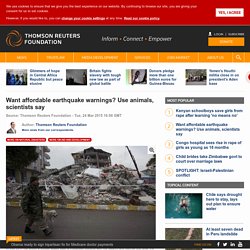
REUTERS/Morteza Nikoubazl LONDON, March 24 (Thomson Reuters Foundation) - Wild animals can predict earthquakes several weeks before they strike, and motion-activated cameras that track their movements could be adopted in quake-prone countries as an affordable early warning system, scientists said on Tuesday. Scientists using a series of cameras in an Amazon region of Peru noticed changes in animal behaviour three weeks before a 7.0 magnitude quake hit the area in 2011, according to a study published in the journal Physics and Chemistry of the Earth. In a 23-day period before the earthquake, scientists recorded five or fewer animal sightings a day, compared with five to 15 sightings per day previously. FEATURE-Thailand tests floating homes in region grappling with floods - TRFN. Experts brainstorm ways to fund cities to withstand disasters. By Alisa Tang Mon Feb 16, 2015 1:06pm GMT BANGKOK (Thomson Reuters Foundation) - Governments must persuade businesses to invest in protecting cities from natural disasters, and climate and development experts should heed the needs of poor communities hardest hit by climate catastrophes, experts said.
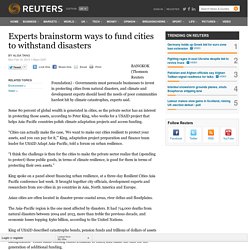
Some 80 percent of global wealth is generated in cities, so the private sector has an interest in protecting those assets, according to Peter King, who works for a USAID project that helps Asia-Pacific countries polish climate adaptation projects and access funding. “Cities can actually make the case, ‘We want to make our cities resilient to protect your assets, and you can pay for it,’” King, adaptation project preparation and finance team leader for USAID Adapt Asia-Pacific, told a forum on urban resilience.
King spoke on a panel about financing urban resilience, at a three-day Resilient Cities Asia Pacific conference last week. The Asia-Pacific region is the one most affected by disasters. LUMKANI – Fire Detection. How robots are changing search and rescue. After natural disasters, it’s often difficult to reach the people who need the most help.

Are small robots, able to fly above damaged areas or crawl into collapsed buildings, the answer? Hurricanes, mudslides, earthquakes and terror attacks often leave widespread damage – and those injured can often be very hard to reach for search and rescue teams. Robots can play a vital role in getting life-saving aid to those in need. In fact, Dr Robin Murphy, director of the Center for Robot-Assisted Search and Rescue at Texas A&M University says they have already had an effect, having been used in incidents such as the 9/11 attacks and the Fukushima tsunami in 2011.
How CrisisNET is Democratising Crisis Data. Chris Albon and the CrisisNET team are on a mission—a mission to democratize crisis data.
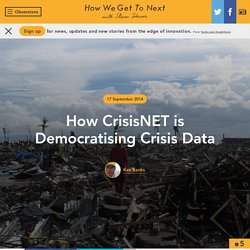
“For the first time, decision-makers and citizens with limited-to-no experience will be able to use social-media generated data to answer their questions without the need for a costly data science team or expensive analysis software,” said Albon, director of CrisisNET. Given the amount of data that now exists, making sense of it—and delivering it in a useful form—is a big deal. Crisis data isn’t new. It’s been available to the disaster-response community for years. The problem is that the vast majority of it used to come from official government sources. A.F.A. is A Powered Exoskeleton Suit for Firefighter. Email.

A new breed of resilience: 'In the 21st century, crisis may be the new normal' Building a stronger, more stable city means getting some fundamental things right – a secure distribution of energy and water, access to healthcare, an efficient transport network.
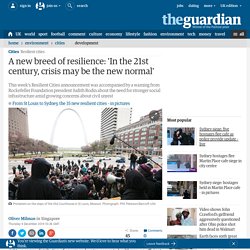
But the ongoing, visceral outrage of protestors throughout the United States at the shooting of Ferguson teenager Michael Brown has thrown cities’ needs for social, as well as physical, betterment into sharp relief. St Louis has been wracked by protests following the decision not to indict Darren Wilson, the police officer who shot Brown in August.
The local NFL team has provoked the ire of the Missouri police union for taking part in the “hands up” protest gesture that has been adopted throughout the country. On Wednesday, the Rockefeller Foundation unveiled a further 35 cities that will take part in its 100 Resilient Cities programme – among them, St Louis. Is New York City ready for future natural disasters? Join our investigation. Exactly two years ago, swaths of New York were in darkness – recovering from a natural disaster for which the city was indisputably unprepared.

In the week following hurricane Sandy’s October visit in 2012, lower Manhattanites sat in blacked-out apartments with no running water. The city’s largest hospitals sat useless, their patients relocated. Engineers were pumping water out of subway and road tunnels throughout the city, though its salt had already destroyed power systems and begun corroding infrastructure. Has Floating Architecture’s Moment Finally Arrived? Community Cellular Networks. Erik Wilkinson: Plan for future disasters by looking at past. By Erik Wilkinson Posted: 11/14/2014 12:22:56 PM MST | Updated: 9 days ago With the one-year anniversary of the 2013 floods behind us, the magnitude and complexity of the recovery effort is becoming clearer.
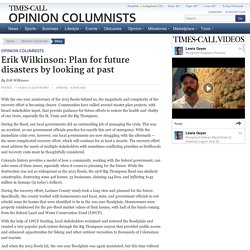
Communities have rallied around master plan projects, with broad stakeholder input, that provide guidance for future efforts to restore the health and vitality of our rivers, especially the St. Vrain and the Big Thompson. During the flood, our local governments did an outstanding job of managing the crisis. Colorado history provides a model of how a community, working with the federal government, can solve some of these issues, especially when it comes to planning for the future. Weather Extremes in a Changing Climate - Hindsight on Foresight - WMO by Nick Watts. NSA Director: Yes, China Can Shut Down Our Power Grids. Elise Amendola/APA National Grid crew member works on a power line in Revere, Massachusetts.

China and "one or two" other countries are capable of mounting cyberattacks that would shut down the electric grid and other critical systems in parts of the United States, according to Adm. Michael Rogers, director of the National Security Agency and head of U.S. Drought looms in Australia as El Niño edges closer in the Pacific Ocean. Australia is edging closer to a drought-inducing El Niño in the Pacific Ocean, the Bureau of Meteorology has warned.

The BoM now says there is a 70% chance of an El Niño by summer’s end, up from 50% just two weeks ago. Above-average sea surface temperatures have continued to rise across the tropical Pacific Ocean in the past two weeks, according to the BoM’s latest fortnightly El Niño southern oscillation wrap-up, released on Wednesday. The southern oscillation index, a measure of surface temperatures, has exceeded El Niño thresholds for the past three months, the BoM report said. “These factors mean the bureau’s ENSO tracker status has been upgraded from ‘watch’ to ‘alert’ level, indicating at least a 70% chance of El Niño occurring,” the report said. Drones Are Tracking Monkeys To Spot Malaria Outbreaks. Solar PowerCube Provides Electricity, Clean Water, and WiFi in Disaster Zones.
Solar PowerCube Provides Electricity, Clean Water, and WiFi in Disaster Zones Following a major disaster, water, energy, and communications can be in short supply—challenging for residents and relief workers alike. How Titanic is helping a South Pacific tribe understand why their island is disappearing — Matter. Tokyo combats flood threats with second mammoth reservoir. A Tiny Electric Car that can Resist Floods and Float on Water. In a very short amount of time we’ve gone from gasoline powered cars to hybrid, electric vehicles (EVs), and fuel cell powered cars. The international automobile industry is responding to these rapid changes by developing new ideas and technology.
One small Japanese venture company, FOMM, is looking at penetrating the Southeast Asian market by developing EVs that can withstand the flood disasters that plague the region – a heretofore unprecedented move. Humanitarian UAV Missions During Balkan Floods. The Balkans recently experienced the heaviest rains in 120 years of recorded weather measurements, causing massive flooding and powerful landslides. Model drone finds elderly man, missing for three days, alive. Typhoons Are Getting So Strong That Focus Is Shifting Away From Recovery. How the U.S. Is Embracing Natural Disasters.
Designing for Disaster.
How to Think Like the Dutch in a Post-Sandy World. Photo. Floating Artificial Coral Reef Station to Protect Indonesian Coastline from Tsunamis. Located in Indian ocean, Floating Artificial Coral Reef Station project will protect Indonesian coastline from Tsunamis as well as support the growth of natural coral. This conceptual electric coral reef station features moveable steel girders as its framework along with steel reef ball structures which are designed in a way to protect coral reef ecosystem. Coral reefs provide shelter for marine life, they are also valuable sources of organisms for potential medicines, at the same time, they also create sand for beaches. A New Tool in the Fight Against Hurricanes: Wind Farms? - John Metcalfe.
Third world and disasters. Man made large disasters. Tech and Gear for Disasters. Risk & Preparedness. Design for disasters. Disasters in the Future. Disaster stats - trends. Early warning systems. Mapping Disasters. Climate.